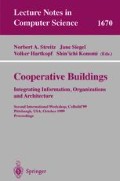Abstract
A concept of complex objects, being artifacts that have one real physical part and several virtual parts representing certain aspects of the object, is introduced. These parts are coupled by bi-directional double links of control and view, enabling a synchronous update of all part, if one of them is changed by user action or internal events. With a construction kit, being a set of compatible complex objects for a certain engineering or office application field, it is possible to build a system in reality with real parts, generating synchronously the assembly of virtual parts by means of a universal graspable user interface. The bi-directional double links allow the control of virtual parts by grasping and pointing on real parts and view the virtual parts by light projection into the real scene and vice versa, that is, control and view real parts by grasping and pointing on virtual parts. The concept is being demonstrated with prototypes for the application areas of pneumatic circuit design and flexible assembly systems.
Access this chapter
Tax calculation will be finalised at checkout
Purchases are for personal use only
Preview
Unable to display preview. Download preview PDF.
References
Brauer, V.: Feature-basierte Erkennung dynamischer Gesten mit einem Datenhandschuh. Universität Bremen, Diplomarbeit (1994)
Brauer, V.: Simulation Model Design in Physical Environments. ACM SIGGRAPH Computer Graphics 30(4) (November 1996)
Bruns, F.W.: Zur Rückgewinnung von Sinnlichkeit – Eine neue Form des Umgangs mit Rechnern. Technische Rundschau 29/30, 14–18 (1993)
Bruns, F.W.: Integrated Real and Virtual Prototyping. In: Proc. 24th Ann. Conf., vol. 4, pp. 2137–2142. IEEE Industrial Society, Los Alamitos (1998)
Fitzmaurice, G.W., Ishii, H., Buxton, W.: Bricks: Laying the Foundations for Graspable User Interfaces. In: CHI 1995 Mosaic of Creativity, pp. 442–449 (1995)
Goldberg, A., Robson, D.: Smalltalk-80: The language and its implementation. Addison-Wesley, Reading (1983)
Grund, S.: BREVIE Evaluation. Presentation at the Concertation Meeting of the EU, Brussels, 22.1.99 (1999) (soon to be published)
Ishii, H., Ullmer, B.: Tangible Bits: Toward Seamless Interfaces between People, Bits and Atoms. In: CHI 1997, Atlanta, Georgia (1997), http://media.mit.edu/groups/tangible
Kang, S.B., Ikeuchi, K.: Grasp Recognition and Manipulative Motion Characterization from Human Hand Motion Sequences. In: Proc. of IEEE Int. Conf. on Robotics and Automation, San Diego, Cal., vol. 2, pp. 1759–1764 (1994)
Krauth, J.: Comparison 2, Flexible Assembly System. EUROSIM Simulation News 2 (May 1992)
Resnick, M.: Behavior Construction Kits. Communications of the ACM 36(7), 64–71 (1993)
Rekimoto, J.: Multiple-Computer User Interfaces: A Cooperative Environment Consisting of Multiple Digital Devices. In: Streitz, N., Konomi, S., Burkhardt, H.-J. (eds.) pp. 42–52 (1998) see next
Streitz, N.A., Konomi, S., Burkhardt, H.-J. (eds.): CoBuild 1998. LNCS, vol. 1370. Springer, Heidelberg (1998)
Suzuki, H., Kato, H.: Interaction-Level Support for Collaborative Learning: AlgoBlock – An Open Programming Language. In: Proc. of the Computer Supported Collaborative Learning (CSCL) Conf., University of Indiana (1995)
Weiser, M.: The Computer for the Twenty-first Century. Scientific American 256(3), 94–104 (1991)
Wellner, P., Mackay, W., Gold, R.: Computer-Augmented Environments: Back to the Real World. Communications of the ACM 36(7), 24 (1993)
Author information
Authors and Affiliations
Editor information
Editors and Affiliations
Rights and permissions
Copyright information
© 1999 Springer-Verlag Berlin Heidelberg
About this paper
Cite this paper
Bruns, W.F. (1999). Complex Construction Kits for Coupled Real and Virtual Engineering Workspaces. In: Streitz, N.A., Siegel, J., Hartkopf, V., Konomi, S. (eds) Cooperative Buildings. Integrating Information, Organizations, and Architecture. CoBuild 1999. Lecture Notes in Computer Science, vol 1670. Springer, Berlin, Heidelberg. https://doi.org/10.1007/10705432_6
Download citation
DOI: https://doi.org/10.1007/10705432_6
Publisher Name: Springer, Berlin, Heidelberg
Print ISBN: 978-3-540-66596-0
Online ISBN: 978-3-540-48106-5
eBook Packages: Springer Book Archive

